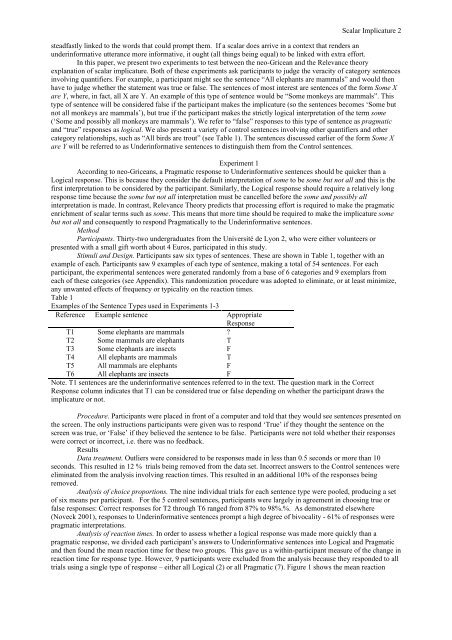SemPrag03.Progr.pdf - Institut für Linguistik/Germanistik - Universität ...
SemPrag03.Progr.pdf - Institut für Linguistik/Germanistik - Universität ...
SemPrag03.Progr.pdf - Institut für Linguistik/Germanistik - Universität ...
Create successful ePaper yourself
Turn your PDF publications into a flip-book with our unique Google optimized e-Paper software.
Scalar Implicature 2<br />
steadfastly linked to the words that could prompt them. If a scalar does arrive in a context that renders an<br />
underinformative utterance more informative, it ought (all things being equal) to be linked with extra effort.<br />
In this paper, we present two experiments to test between the neo-Gricean and the Relevance theory<br />
explanation of scalar implicature. Both of these experiments ask participants to judge the veracity of category sentences<br />
involving quantifiers. For example, a participant might see the sentence “All elephants are mammals” and would then<br />
have to judge whether the statement was true or false. The sentences of most interest are sentences of the form Some X<br />
are Y, where, in fact, all X are Y. An example of this type of sentence would be “Some monkeys are mammals”. This<br />
type of sentence will be considered false if the participant makes the implicature (so the sentences becomes ‘Some but<br />
not all monkeys are mammals’), but true if the participant makes the strictly logical interpretation of the term some<br />
(‘Some and possibly all monkeys are mammals’). We refer to “false” responses to this type of sentence as pragmatic<br />
and “true” responses as logical. We also present a variety of control sentences involving other quantifiers and other<br />
category relationships, such as “All birds are trout” (see Table 1). The sentences discussed earlier of the form Some X<br />
are Y will be referred to as Underinformative sentences to distinguish them from the Control sentences.<br />
Experiment 1<br />
According to neo-Griceans, a Pragmatic response to Underinformative sentences should be quicker than a<br />
Logical response. This is because they consider the default interpretation of some to be some but not all and this is the<br />
first interpretation to be considered by the participant. Similarly, the Logical response should require a relatively long<br />
response time because the some but not all interpretation must be cancelled before the some and possibly all<br />
interpretation is made. In contrast, Relevance Theory predicts that processing effort is required to make the pragmatic<br />
enrichment of scalar terms such as some. This means that more time should be required to make the implicature some<br />
but not all and consequently to respond Pragmatically to the Underinformative sentences.<br />
Method<br />
Participants. Thirty-two undergraduates from the Université de Lyon 2, who were either volunteers or<br />
presented with a small gift worth about 4 Euros, participated in this study.<br />
Stimuli and Design. Participants saw six types of sentences. These are shown in Table 1, together with an<br />
example of each. Participants saw 9 examples of each type of sentence, making a total of 54 sentences. For each<br />
participant, the experimental sentences were generated randomly from a base of 6 categories and 9 exemplars from<br />
each of these categories (see Appendix). This randomization procedure was adopted to eliminate, or at least minimize,<br />
any unwanted effects of frequency or typicality on the reaction times.<br />
Table 1<br />
Examples of the Sentence Types used in Experiments 1-3<br />
Reference Example sentence Appropriate<br />
Response<br />
T1 Some elephants are mammals ?<br />
T2 Some mammals are elephants T<br />
T3 Some elephants are insects F<br />
T4 All elephants are mammals T<br />
T5 All mammals are elephants F<br />
T6 All elephants are insects F<br />
Note. T1 sentences are the underinformative sentences referred to in the text. The question mark in the Correct<br />
Response column indicates that T1 can be considered true or false depending on whether the participant draws the<br />
implicature or not.<br />
Procedure. Participants were placed in front of a computer and told that they would see sentences presented on<br />
the screen. The only instructions participants were given was to respond ‘True’ if they thought the sentence on the<br />
screen was true, or ‘False’ if they believed the sentence to be false. Participants were not told whether their responses<br />
were correct or incorrect, i.e. there was no feedback.<br />
Results<br />
Data treatment. Outliers were considered to be responses made in less than 0.5 seconds or more than 10<br />
seconds. This resulted in 12 % trials being removed from the data set. Incorrect answers to the Control sentences were<br />
eliminated from the analysis involving reaction times. This resulted in an additional 10% of the responses being<br />
removed.<br />
Analysis of choice proportions. The nine individual trials for each sentence type were pooled, producing a set<br />
of six means per participant. For the 5 control sentences, participants were largely in agreement in choosing true or<br />
false responses: Correct responses for T2 through T6 ranged from 87% to 98%.%. As demonstrated elsewhere<br />
(Noveck 2001), responses to Underinformative sentences prompt a high degree of bivocality - 61% of responses were<br />
pragmatic interpretations.<br />
Analysis of reaction times. In order to assess whether a logical response was made more quickly than a<br />
pragmatic response, we divided each participant’s answers to Underinformative sentences into Logical and Pragmatic<br />
and then found the mean reaction time for these two groups. This gave us a within-participant measure of the change in<br />
reaction time for response type. However, 9 participants were excluded from the analysis because they responded to all<br />
trials using a single type of response – either all Logical (2) or all Pragmatic (7). Figure 1 shows the mean reaction

















